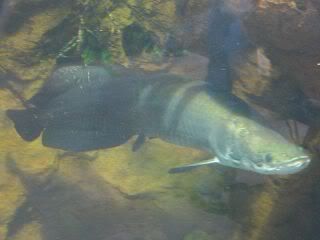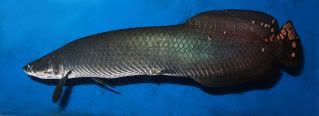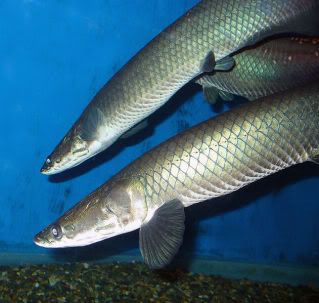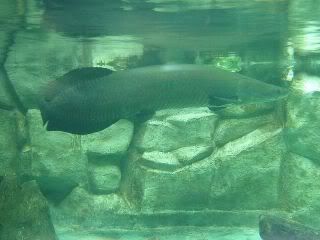Assalamualaikum and Peace be upon all of you.
Welcome to my blog.
It is good to finally find a suitable topic for my Flora and Fauna sections as it is already 2 months since my last post. This month Flora and Fauna section will cover about a giant fresh water fish called as Arapaima Gigas. Still remember the “Dragon Fish” that currently still terrorizing Tasik Kenyir? In June 2009, according to the local townsfolk, the Arapaima Gigas is claimed to be responsible for the mysterious drowning of 2 men. The local (at Tasik Kenyir) refers the fish as ‘Dragon Fish’ or ‘Kenyir Monster’.
The arapaima, pirarucu, or paiche (Arapaima gigas) is a South American tropical freshwater fish. It is one of the largest freshwater fishes in the world.
CHARACTERISTIC
Arapaima can reach lengths of more than 2 m (6.6 ft), in some exceptional cases even more than 2.5 m (8.2 ft) and over 100 kg (220 lbs). The often cited maximum length of 4.5 m (14.8 ft) comes from a single second-hand-report from the first half of the nineteenth century, and is not confirmed. The maximum-cited weight for the species is 200 kg (440 lbs). As one of the most sought after food fish species in South America, it is often captured primarily by handheld nets for export, by spearfishing for local consumption, and, consequently, large arapaima of more than 2 m are seldom found in the wild today.
HABITAT
The fish is native at South America primarily at the flooded rainforest along the Amazon River. The arapaima has also been introduced for fishing in Thailand and Malaysia.
ECOLOGY
The diet of the arapaima consists of fish, crustaceans, and other small animals. The fish is an air-breather, using its swim bladder, which is rich in blood vessels and opens into the fish's mouth, an advantage in oxygen-deprived water that is often found in the Amazon River. This fish is therefore able to survive in shallow waters with dissolved oxygen as low as 0.5 ppm.
Due to the geographic range that arapaima inhabit, the animal's life cycle is greatly affected by the seasonal flooding that occurs. The arapaima lays its eggs during the months of February, March, and April when the water levels are low or beginning to rise. They build a nest approximately 50 cm wide and 15 cm deep, usually in muddy bottomed areas. As the water rises the eggs hatch and the offspring have the flood season to prosper, during the months of May to August. Therefore, the yearly spawning is regulated seasonally. The arapaima male is supposed to be a mouthbrooder, like its relative the Osteoglossum spp., meaning the young are protected in its mouth until they are older. The female arapaima helps to protect the male and the young by circling them and fending off potential predators.
IMPORTANCE
Arapaima are harpooned or caught in large nets and the meat is said to be delicious. Since the arapaima needs to swim up to breathe air, traditional arapaima fishers often catch them by first harpooning them and then clubbing them dead. One individual can yield as much as 70 kg of meat.
It is also considered an aquarium fish, although it obviously requires a large tank and ample resources. This animal also appears in the pet trade, although to keep an arapaima correctly requires a large tank and can prove quite difficult.
The tongue of this fish is thought to have medicinal qualities in South America. It is dried and combined with guarana bark, which is grated and mixed into water. Doses of this are given to kill intestinal worms. In addition, the arapaima's bony tongue is often used to scrape cylinders of dried guarana, an ingredient in some beverages, and the bony scales are used as nail files.
In Malaysia and Thailand, the arapaima has been introduced for fishing
COMMENT
Personally, I am still searching for the conservation status for this fish. It doesn’t look like that this fish is actually an endangered species.
How the arapaima which is native in Amazon is found living in Kenyir Lake?
A popular rumor stated that, the fish is kept in one of the resort at the lake. And the fish somehow manage to escape into the lake. After the mysterious drowning of 2 men is revealed, the Terengganu Government has officially announce a RM 10 000 reward for someone who able to capture it. It is to prevent the fish to somehow destroy the ecosystem in the lake. (Of course... the fish is supposedly not belonging at the lake).
Anyway.. good luck guys..!
skip to main |
skip to sidebar














Land of Nine Kings
Blog Owner
Radin Twitter
The Royal Library
The Chamber of Patriotism
Rule of Law
My Blog List
-
-
Pregnancy and Childbirth in France6 months ago
-
-
-
-
-
Collections7 years ago
-
-
-
-
Ratu Fabiola of Belgium Mangkat Pada Jumaat11 years ago
-
RAJA NAZRIN DIMASYHURKAN SULTAN PERAK KE 3511 years ago
-
KELAM DI BALIK MENDUNG (akhir)12 years ago
-
Surat untuk kekasih imaginari12 years ago
-
-
-
-
-
-
Blog Clock
Prayer Time
Blog Counter
Feedjit
Blog Visitor
Project Alpha
(remove until further notice)
Pages
Powered by Blogger.
Nuffnang
Labels
- Architecture (15)
- Blog (81)
- Events (37)
- Govenorate Portal (86)
- Miscellaneous (14)
- Persona (10)
- Pujangga Alam (8)
- Royal Portal (686)
- Video Collections (2)
News by State
- Agong (183)
- Johor (104)
- Pahang (82)
- Selangor (82)
- Perlis (70)
- Perak (67)
- Kelantan (66)
- Kedah (58)
- Negeri Sembilan (48)
- Sarawak (40)
- Terengganu (39)
- Sabah (36)
- Melaka (31)
- Pulau Pinang (29)
Sultanate of Johor Darul Takzim

Sultanate of Pahang darul Makmur

Sultanate of Terengganu Darul Iman

Sultanate of Kelantan Darul Naim

Kingdom of Perlis Indera Kayangan

Sultanate of Kedah Darul Aman

Sultanate of Perak Darul Ridzuan

Sultanate of Selangor Darul Ehsan

Confederation of Negeri Sembilan Darul Khusus

State of Sarawak, The Land of Hornbill

State of Sabah, The land beneath the wind

State of Pulau Pinang, the Pearl of Orient

State of Melaka, The Historical City

WordPress Theme Design by FThemes.com | Bloggerized by Agus Ramadhani - Zoomtemplate.com
Power by Blogger.com
Power by Blogger.com
 RSS Feed
RSS Feed Twitter
Twitter







2 comments:
I recently came across your blog and have been reading along. I think I will leave my first comment. I don’t know what to say except that I have enjoyed reading. Nice blog. I will keep visiting this blog very often.
I am really impressed by the work you did in this article. It’s great enough to pull my attention and in reading this article for once to understand that your pen is really mightier than the sword.
Fly Fishing Rods
Post a Comment